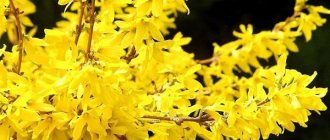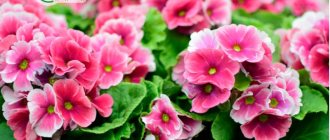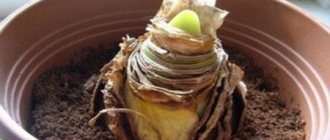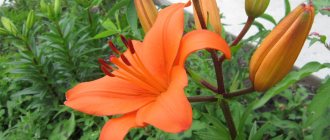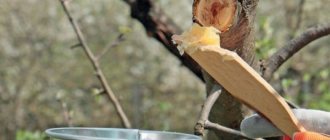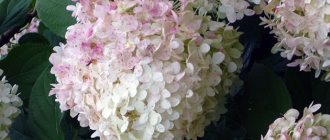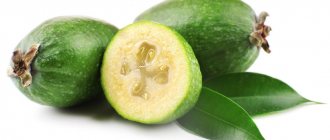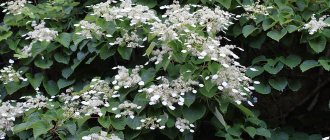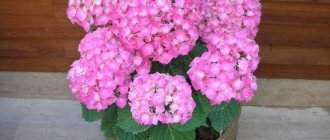Hydrangeas have firmly entered gardens and parks as long-flowering shrubs. The flowering time of each garden hydrangea bush depends on the variety, pruning method, and weather conditions.
Breeding research in the field of breeding new decorative flowering hydrangea varieties has been going on for about a hundred years. This explains such a wide variety of garden hydrangea varieties. Initially, lush flowering was observed only for two or three summer months. Gradually this period expanded to three to four months. Although, there are varieties that bloom only for one and a half to two months.
Short-flowering hydrangeas differ from most varieties in their unusual decorative features.
When does hydrangea bloom?
The flowering time of hydrangea depends on the variety, planting time and care. Some flowers bloom at the end of May and stop blooming in June-July, others can bloom in October, as long as it is warm.
Pink hydrangea looks very delicate
Flowering period
The term and duration of flowering depends on the variety. Some plants bloom as early as April, but most often flowering occurs in the following months:
- May June. At this time, the Green Racer hydrangea blooms. It is a tall vine with cream, flat and shield-shaped flowers.
- End of June – July. This month, Invisible Spirit (a tree-like variety with pink buds), Vanilla Fraze, which changes the color of the inflorescences during flowering from white to pink, Cadlelight (a paniculate variety with huge white flowers) and Phantom (has pink and then cream inflorescences) bloom. Green Racer blooms on last year's shoots.
- Aug. Sept. This is the flowering time for varieties such as Annabelle, Peppermint, Pinky Winky, Phantom and Candlelight.
- October. Hydrangea varieties Anabelle, Peppermint, Phantom and Candlelight continue to bloom. Most of the plants have already bloomed by this time.
Invisible has pink buds
Important! If you plant several hydrangeas with different flowering periods in your garden, you don’t have to worry about decorating it in spring, summer, or fall. Freshly cut flowers are placed in a vase and beautiful bouquets are created from them.
Features of hydrangea flowering
Hydrangea is a demanding plant. Its flowering is associated with some features, knowledge of which helps to achieve better results when growing a flower in large quantities or individually in the garden. So, the plant:
- It does not bloom every year; if the conditions are not suitable, there may be no buds or there will be few of them.
- Capable of changing the shade of panicles during flowering. This can be done artificially by increasing the acidity of the soil, and then the panicles will acquire more saturated, bright colors.
- Requires regular pruning. This helps increase the number of young flowering shoots next year.
The level of acidic substances in the soil changes as the root and above-ground parts of the plant develop. To increase acidity, organic and mineral fertilizers are added to the soil. The required shade of buds is acquired by spilling the soil with an alkaline or acidic solution.
Candlelight looks luxurious due to its two-color inflorescences
Necessary conditions for flowering
Hydrangea pleases not all gardeners with its abundant flowering. She is capricious and needs the following care:
- Regular watering. Water generously immediately after transplanting and in extreme heat. If summer and autumn are rainy, then experts recommend watering only when the top soil layer dries out.
- Pruning. The buds formed this year are needed for future flowering. They do not cut at the root, leaving a stem up to 30-40 cm high above the surface. It is better to do this in the spring, cutting off all the dried branches and leaving at least 10 buds on each viable stem. Inflorescences are cut in autumn.
- Good lighting. The plant does not like direct sunlight, but does not do well in the shade. It is better to plant it in a place shaded by other plants or a fence.
Replanting is necessary if the soil becomes poor
Flowering should not be expected if the soil is not fertilized, has dried out since spring due to lack of rain, and the area where the plant is planted is blown by winds.
Much depends on climatic conditions; in the northern regions, hydrangea is grown in a greenhouse or only late-flowering and frost-resistant varieties are planted in the ground. It will not be possible to force other varieties to bloom due to cold weather.
Hovaria
The Hovaria series includes winter-hardy varieties, each of which captivates with its unique beauty.
Love You Kiss bushes are covered with white inflorescences, and the edges of the petals are decorated with a wavy outline of bright pink color.
Hopcorn flowers can change colors from pink to deep purple.
The dark purple flowers of Holibee look impressive, and the sophisticated blue-lilac inflorescences of Homigo look very delicate.
Recent Entries
Lilac perennials that are beautiful, compact and do not crowd out other plants Why when buying seedlings you should not take the sellers’ word for it and how to determine the age of the plant using 3 signs Tomato seedlings have turned purple or whitish: why the color has changed and how to save the plants
Hopaline is very unusual with carved edges and a yellow-green center of white inflorescences.
What year does hydrangea bloom?
Rhododendron: what is it, how long does it bloom?
Home flowers grow in the garden without transplantation for 20-30 years in a row. Potted indoor crops need to be renewed every 5-6 years. Most of all, flower growers are concerned about what year hydrangea begins to bloom and when it needs to be planted in order to get bouquets for sale.
Watering should be regular
With proper autumn planting, young cuttings acquire a large number of leaves and produce flower stalks the following spring. Several months pass from planting to flowering of large-leaved varieties.
The exception is paniculate varieties, which can bloom 3-4 years after planting in open ground. They can also be planted in the warm season.
History of the name
The name “hydrangea” was given to the plant by Philibert Commerson, it is derived from the Latin hortus (garden). Since Hortense was a common female name in this era, many versions arose about the woman to whom this name could be dedicated: from Nicole-Reine Lepot, who could be called Hortense in the family, to Princess Hortense - the sister of Prince of the Holy Roman Empire Karl Heinrich of Nassau-Siegen .
Later, European botanists-taxonomists gave the plant the name Hydrangea, which can be translated as “vessel of water” (ancient Greek ὕδωρ - water, ἄγγος - vessel). According to one version, the name was given to hydrangea for the shape of the seed pods, reminiscent of a jug, according to another - for its moisture-loving nature.
In Japan they are called Ajisai. Writing the name of a flower in hieroglyphs can be translated as “purple solar flower”, “flower similar to the purple sun”.
How to get hydrangea to bloom in the garden
Primrose when it blooms: ripening period and changes in flower care
If your hydrangea doesn't bloom, you can try:
- transplant it to a new place;
- feed the plant with suitable fertilizer;
- trim tree branches overhanging the flower.
A long absence of flowering is sometimes due to the fact that the expanding root system of broadleaf hydrangea intertwines with the roots of other plants. They begin to interfere with each other and develop, drawing out useful minerals and substances. When planting, maintain a distance of 0.8-1 m between hydrangea bushes and other garden plants.
Buds will appear only with good care
Blue Heaven
Blue Heaven is a beautiful shrub 0.9-1.2 m tall, blooming from July until the first weeks of autumn. The peculiarity of Blue Heaven is its large, ball-shaped inflorescences, up to 30 cm in diameter. Flower petals can be pink, bright blue or lilac.
This is a moisture-loving hydrangea, so mulching should be used to maintain the desired level of humidity.
Blue Heaven hedges and borders are popular in landscape design.
Proper feeding of garden hydrangea for flowering
Why does hydrangea bloom green and what to do?
An adult plant that does not receive the micronutrients it needs may not bloom every year or may produce small, unsightly panicles. To achieve lush flowering, use the following types of fertilizers:
- nitrogenous fertilizers (applied in spring);
- potassium;
- phosphorus (all year round, except late autumn and winter).
These fertilizers are applied to the soil in doses. Oversaturation of a plant with nitrogen leads to the growth of green mass, the flowers become smaller, and the panicles are reduced by 2 times.
In autumn, the bushes are fed with organic fertilizers. It can be humus or mullein. To obtain panicles of an unusual shade, red peat or aluminum alum is added to the soil in the spring.
Mulching is necessary to retain moisture in the soil
Prevention of diseases and pests
Hydrangea does not often, but gets sick and suffers from pest attacks. Gardeners should be wary of the following diseases:
- chlorosis – the color of the leaf plate changes, the plant becomes weak, unable to survive in possibly difficult climatic conditions;
- white rot - affects the root system, which leads to the death of the entire bush;
- gray rot;
- septoria;
- powdery mildew;
- rust;
- ring spot is a viral disease that manifests itself in the form of spots on the leaves and cannot be treated.
Gray rot is dangerous for flowering bushes
Bushes are affected by leaf aphids, spider mites and slugs. To prevent plant death:
- Choose the right planting site - close proximity to groundwater can lead to rotting of the roots.
- Water regularly - lack of watering weakens the flowers, they become less resistant to diseases and pests.
- They feed - nitrogen must be added to the soil in May, phosphorus and potassium in the summer, and only phosphorus in the fall.
- The bushes are treated with copper sulfate, dissolving 100 g of it in 10 liters of water.
To control pests, poisonous agents such as Topaz or Fitosporin are used. In addition, they regularly weed the ground under the bushes, and also inspect the plants for pest damage. Dry leaves and branches are removed.
Important! After heavy watering or heavy rains, the soil under the hydrangeas is loosened. They do this carefully, trying not to damage the roots and give them access to air.
When and how to prune hydrangeas correctly
If winters are harsh and the air temperature drops below -10-15 degrees, it is better to cover the bushes with a hut built from wooden trellises and spruce branches. You can also dig up the flowers and replant them in a pot, placing it for storage on the balcony or in a warm cellar.
Spider mite
The plant does not like pruning at the root, which is often practiced by gardeners who do not want to worry about creating a hut as a shelter. A plant cut in this way will quickly grow green mass, but will not bloom next year.
Several types of pruning are practiced:
- Sanitary. The bushes are inspected, damaged branches, ugly or improperly formed young shoots are removed.
- Rejuvenating. Age is important for flowering. Old stems that are more than 3-4 years old are removed. This is usually done if no flowering buds have formed on them this summer.
- In order to produce a large number of flowering panicles. Only the frozen ends of the branches or dry stems are removed; at least 4 buds, preferably 10, are left on each healthy stem.
Pruning is carried out to thin out dense plantings. Remove weak, non-beneficial shoots and shoots growing towards the center of the bush. This can be done in spring or autumn.
Spring pruning allows you to:
- give the bush the desired shape;
- accelerate plant development;
- increase the number of peduncles;
- protect petiole shoots from freezing during spring frosts.
Pruning can be done in March or the first half of April. If there is still snow on the street, it’s not scary, on the contrary, it’s good, it hardens the plant. The main thing is that by the time the procedure is carried out, the growth buds begin to bloom, since without them it is difficult to distinguish healthy branches from dry ones.
Important! Pruning is carried out only when the weather is suitable. In severe frost, bushes are not pruned.
The gardener must know exactly what variety of hydrangea he is growing. For example, tree-like plants are pruned in early March, and paniculate plants in April. Some varieties bloom on new shoots, while others bloom on last year’s shoots, and if you cut them off, there will be no flowering.
Old dry branches are disposed of before sap flows down the stems.
Trimming times vary by region. In the south it is March-April. In the northern regions it can be pruned in September-November. Optimum temperature +9-10 °C. You can’t cut off too much: the smaller the volume of the cut stem, the more abundant the flowering.
Reproduction
There are several ways to propagate garden hydrangeas.
- Green cuttings. They are cut in early summer from young growth. For rooting, take a piece of the stem with two internodes, remove the lower leaves, and cut the upper leaves in half. The cutting is placed in a loose hydrangea substrate, watered, and covered with a transparent cap. Usually, roots appear within 2–3 weeks.
- Dividing the bush. A large bush can be divided into several parts. This is best done in the fall.
- By layering. In spring, a low inclined branch is pressed to the soil, pinned and covered with earth. By autumn it forms its roots.
On a plant obtained from a cutting, in the first year of growth, the flowers are removed so that the bush becomes stronger.
Green cuttings are the easiest and fastest way to propagate garden hydrangea.
Care after flowering
After flowering is complete:
- Remove dried flower stalks.
- Fertilize the plant. They are fed to stimulate the growth of new shoots and protect against rapid growth of shoots; they should not stretch.
- Bushes are being spudded. New soil is poured under each one, making a slide.
- Mulch the soil. A mixture of compost, manure, peat and humus is poured under each bush in a layer of 5 cm.
Removing old flower stalks is necessary to protect the plant. The panicles, swollen from rain and snow, become very heavy. The stems cannot support the weight and break.
At the end of October, hydrangea is protected from frost. If the winter is snowy, then some varieties can be left without artificial shelter, constructing it from snow. Tree, ground cover and tree hydrangeas tolerate cold well.
Removing panicles
What to do if hydrangea does not bloom
If the soil is fertilized, the bush has been properly pruned, it is regularly weeded and watered, but there is still no flowering, you can try the following:
- Transplant the flower not to a new place, but into a large tub filled with a substrate purchased in a store and suitable for a specific plant variety;
- Reduce or increase watering.
- Cover the bush from the sun's rays. Excess light is just as harmful as its lack.
- Buy and plant another variety of flower in the garden; perhaps the climate is not suitable for the one growing on the site.
If the question of why hydrangea does not bloom is still not resolved, they try to completely separate its bushes from other plants. Perhaps the reason is crowding.
Landing
The best time to plant hydrangea is spring. But if the seedling is purchased in a container, it can be planted throughout the warm season.
To give the plant a good start, the planting hole must be large enough. Place drainage on the bottom and fill it with loose nutrient substrate with an acidic pH reaction. Mixtures intended for azaleas, rhododendrons, and heathers are suitable.
When replanting from a pot, you need to remove the roots twisted in a spiral, and carefully straighten the rest, cover with soil at the same level as the plant was planted, and water generously.
Transferring from a pot to a planting hole is the most painless way to plant hydrangeas.
Soil composition
The soil should be light, nutritious, permeable and acidic.
Peat chips, compost and crushed pine needles are poured into the hole before planting the bush. Soil acidity is increased using ammonium sulfate, sulfuric acid or ferrous sulfate. They are part of most complex fertilizers.
Drainage is made from a mixture of fine expanded clay and leafy soil. Hydrangea grows well on loam, but it is not suitable for rich black soil. Ideal soil composition:
- turf land;
- peat crumb;
- leaf humus;
- coarse sand;
- black soil mixed with coarse sand.
The main components are taken in equal quantities.
Shelter for the winter is necessary to prevent the bushes from freezing
Rules and terms of feeding
The main rule that must be followed when caring for hydrangea. It is better to apply less fertilizer than to exceed the permissible rate. Feed from March to October.
If a gardener grows some exotic variety, then it should be fed only after consulting with specialists who already have experience in growing it.
Illumination of the place
The landing site is chosen on a hill or hillock. The flower loves the sun, but direct rays are harmful to it, so sometimes it is planted near a fence or a small tree that does not provide much shade.
In spring, the bushes should warm up well, so plants that could prevent this should not be grown near them.
Hydrangea is a flowering perennial. Most often it is a shrub, but tree-like varieties are also found. The time when hydrangea blooms after planting and the duration of flowering depend on the species, climate and care. It is quite possible to grow beautiful collection varieties in a garden plot. To do this, it is enough to feed, water and prune them correctly.
